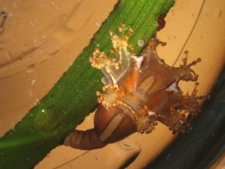Staurozoa: Difference between revisions
Appearance
Content deleted Content added
mNo edit summary |
mNo edit summary |
||
| Line 11: | Line 11: | ||
'''Staurozoa''' is a [[class (biology)|class]] of [[Medusozoa]], jellyfishes and hydrozoans. It has one extant order, [[Stauromedusae]] (stalked jellyfishes), and one extinct order, Conulatae.<ref>{{Cite web|url=http://marinespecies.org/aphia.php?p=taxdetails&id=265044|title=WoRMS - World Register of Marine Species - Staurozoa|website=marinespecies.org|language=en|access-date=2018-03-21}}</ref> The extinct order is largely unknown and described as a possibly [[cnidaria]]n clade of marine life with shell-like structures, the [[Conulariida]]. Staurozoans are small animals ({{cvt|1-4|cm|1|disp=or}}) that live in marine environments, usually attached to seaweeds, rocks, or gravel.<ref name="Collins">Collins, A. G. (n.d.). Staurozoa. ''AccessScience''. doi:10.1036/1097-8542.652700</ref> They have a large antitropical distribution, a majority found in boreal or polar, near-shore, and shallow waters. Few staurozoans are found in warmer tropical and subtropical water environments of the Atlantic, Indian, and Pacific Ocean basins, but most are known from the Northern Hemisphere.<ref name="Collins" /> |
'''Staurozoa''' is a [[class (biology)|class]] of [[Medusozoa]], jellyfishes and hydrozoans. It has one extant order, [[Stauromedusae]] (stalked jellyfishes), and one extinct order, Conulatae.<ref>{{Cite web|url=http://marinespecies.org/aphia.php?p=taxdetails&id=265044|title=WoRMS - World Register of Marine Species - Staurozoa|website=marinespecies.org|language=en|access-date=2018-03-21}}</ref> The extinct order is largely unknown and described as a possibly [[cnidaria]]n clade of marine life with shell-like structures, the [[Conulariida]]. Staurozoans are small animals ({{cvt|1-4|cm|1|disp=or}}) that live in marine environments, usually attached to seaweeds, rocks, or gravel.<ref name="Collins">Collins, A. G. (n.d.). Staurozoa. ''AccessScience''. doi:10.1036/1097-8542.652700</ref> They have a large antitropical distribution, a majority found in boreal or polar, near-shore, and shallow waters. Few staurozoans are found in warmer tropical and subtropical water environments of the Atlantic, Indian, and Pacific Ocean basins, but most are known from the Northern Hemisphere.<ref name="Collins" /> |
||
==Gallery== |
|||
<gallery widths="225" heights="175" style="text-align:center"> |
|||
File:Haliclystus stejnegeri 1.jpg|''[[Haliclystus stejnegeri]]'' |
|||
File:Haliclystus antarcticus 1C.jpg|''[[Haliclystus antarcticus]]'' |
|||
File:6 or-Manania handi.tif|''[[Manania handi]]'' |
|||
</gallery> |
|||
==References== |
==References== |
||
Revision as of 08:00, 18 August 2019
| Staurozoa Temporal range:
| |
|---|---|

| |
| Scientific classification | |
| Domain: | Eukaryota |
| Kingdom: | Animalia |
| Phylum: | Cnidaria |
| Subphylum: | Medusozoa |
| Class: | Staurozoa Marques & Collins, 2004 |
| Orders | |
Staurozoa is a class of Medusozoa, jellyfishes and hydrozoans. It has one extant order, Stauromedusae (stalked jellyfishes), and one extinct order, Conulatae.[2] The extinct order is largely unknown and described as a possibly cnidarian clade of marine life with shell-like structures, the Conulariida. Staurozoans are small animals (1–4 cm or 0.4–1.6 in) that live in marine environments, usually attached to seaweeds, rocks, or gravel.[3] They have a large antitropical distribution, a majority found in boreal or polar, near-shore, and shallow waters. Few staurozoans are found in warmer tropical and subtropical water environments of the Atlantic, Indian, and Pacific Ocean basins, but most are known from the Northern Hemisphere.[3]
Gallery
References
- ^ Liu, A. G.; Matthews, J. J.; Menon, L. R.; McIlroy, D.; Brasier, M. D. (22 October 2014). "Haootia quadriformis n. gen., n. sp., interpreted as a muscular cnidarian impression from the Late Ediacaran period (approx. 560 Ma)". Proceedings of the Royal Society B: Biological Sciences. 281 (1793): 20141202. doi:10.1098/rspb.2014.1202. PMC 4173675. PMID 25165764.
- ^ "WoRMS - World Register of Marine Species - Staurozoa". marinespecies.org. Retrieved 2018-03-21.
- ^ a b Collins, A. G. (n.d.). Staurozoa. AccessScience. doi:10.1036/1097-8542.652700




